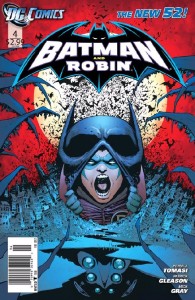 Batman & Robin is a textbook case of the dangers inherent in telling a decompressed comics story. The first issue read to me as a wretched Goddamned mishmash of elements from Christopher Nolan’s Batman movies and the old 60s TV show: big, silly action – including riding Batpoles, and not in that good superhero porno parody way – combined with the introduction of some darker elements, like a new villain who dissolves his enemies in acid. It was a frustrating experience in cognitive dissonance, like watching Cesar Romero tie Adam West to a giant roman candle and then chop Burt Ward’s foot off with a rusty machete.
Batman & Robin is a textbook case of the dangers inherent in telling a decompressed comics story. The first issue read to me as a wretched Goddamned mishmash of elements from Christopher Nolan’s Batman movies and the old 60s TV show: big, silly action – including riding Batpoles, and not in that good superhero porno parody way – combined with the introduction of some darker elements, like a new villain who dissolves his enemies in acid. It was a frustrating experience in cognitive dissonance, like watching Cesar Romero tie Adam West to a giant roman candle and then chop Burt Ward’s foot off with a rusty machete.
The first issue was so dissatisfying that I was prepared to drop the book from my pulls, except I didn’t want to risk accidentally losing Scott Snyder’s Batman by accident. And I am glad that I didn’t, because the subsequent three issues, which tie up the opening story arc, have proven that Batman & Robin deserves to stand with Snyder’s Batman and Tony Daniel’s Detective Comics as some of the most rock-solid, entertaining Batman comics in years. Sometimes I’m glad to be wrong.
Let’s get some of the prejudicial facts out of the way up front: I have never particularly liked Damian Wayne. Since his introduction he has often been written as a bitchy little brat, to the point where Amanda has sometimes gotten the both of us laughing by reading Damian’s dialogue in the voice of Stewie from Family Guy. Try it yourself, it’s fun: “Now look here, Pennyworth…”
But Tomasi’s Batman & Robin is the first time I’ve gotten a clear, empathetic hook into the Robin character: he’s a kid who’s trying to impress his father. But he’s failing, and he’s acting out because he thinks he’s doing what he’s supposed to, even though he wants to be doing something else… and still it doesn’t seem to be working. It is well-written character work, and it is almost all show-don’t-tell: Robin thrilled to be working with Batman, and lashing out when Batman won’t share basic information about their nemesis. It reminds me of how actual kids act, and why I don’t have any. That and the court orders. But I digress.
Don’t get me wrong: Damian’s still fucking annoying – there’s a nice moment where he’s poking Bruce in the head trying to reproduce a kung-fu move Robin saw Bruce perform earlier, which would cause problems if I were Batman, because who needs a Robin with no fucking fingers? And there is a moment where Tomasi cops out on the showing instead of telling by having Alfred spend a page explaining to Bruce, and by extension, us, what Damian is feeling and why. But any writer who can make me empathize with a character I innately dislike is generally doing it right.
The book isn’t all introspective character study – only 9/20th of it, actually. The rest of it includes a pretty tight little deathtrap escape sequence, meaning yes, there are still hints of the old 60s Batman feel… but it has a little bit more urgent feel when Robin’s paralyzed and, as opposed to lighting Ye Olde Roman Candle, Nobody’s preparing to shoot Batman in the face. The escape sequence pays off on what seems like a page-one offhand comment by Batman, and shows why Alfred is the butler the discerning rich man hires when he absolutely has to shoot every motherfucker in the room. If the Adam West show had deathtrap escapes like this, it would still be on the air.
Patrick Gleason’s art is much the same as it was in the first issue: somewhat cartoony, simple and abstract. He has one of those styles that probably isn’t for everybody, but it’s not completely out of place considering that half of all comic readers were introduced to Batman via the Bruce Timm-designed animated series. However, it might be somewhat offputting to the new comics readers that the New 52 was meant to draw in, who might be expecting a more conventionally-drawn figure and facial expression. Whether his art is your cup of tea or not, I was willing to forgive almost anything for the page 10 splash. I might be willing to trade my SDCC return plane ticket for a Greyhound ride to be able to afford that original art… and I definitely would if Gleason would agree to white Robin out of it.
In the final analysis, the first issue of this book felt like a disaster. It read to me like a hideous mix of old, corny and new, darker Batman… and it still kinda is. But what I missed the first time around was the top-shelf character study of what it might like to be the son of Batman, and what it might be like to try to live up to that. Jesus, my Dad was a fucking insurance adjuster, and I still usually feel like a constant and horrific disappointment. So I can feel for Damian… and the fact that Tomasi made me do so is a stellar endorsement.
First impressions aren’t always the best. Check this book out.
 Podcast RSS Feed
Podcast RSS Feed iTunes
iTunes Google Play
Google Play Stitcher
Stitcher TuneIn Radio
TuneIn Radio Android
Android Miro Media Player
Miro Media Player Comics Podcast Network
Comics Podcast Network